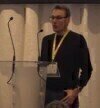Differential Absorption LIDAR (DIAL) measurements of landfill methane emissions
Methane is one of the most important gaseous hydrocarbon species for both industrial and environmental reasons. Understanding and quantifying methane emissions to atmosphere is an important element of climate change research. Range-resolved infrared Differential Absorption Lidar (DIAL) measurements provide the means to map and quantify a wide range of different methane sources.
DIAL is a powerful technique that can be used to track and quantify plumes emitted from area emission sources such as landfill sites, waste water treatment plants and petrochemical plants. By using lidar (light detection and ranging), the DIAL technique is able to make remote range-resolved single-ended measurements of the actual distribution of target gases in the atmosphere, with no disruption to normal site operational activities. DIAL provides 3D mapping of emission concentrations and quantification of emission rates for a wide range of target gases such as methane.
The NPL DIAL laser source is operated alternately at two similar wavelengths. One of these, termed the "on-resonant wavelength", is chosen to be at a wavelength which is absorbed by the target species. The other, the "off-resonant wavelength", is chosen to be at a nearby wavelength which is not absorbed significantly by the target species. The two wavelengths are chosen to be close, so that the atmospheric scattering properties are the same for both wavelengths. They are also chosen so that any differential absorption due to other atmospheric species are minimised. Any measured difference in the returned signals is therefore due to absorption by the target gas.
In the typical DIAL measurement configuration the mobile DIAL facility is positioned downwind of the area being investigated. The DIAL laser beam is then scanned in a vertical plane and the distribution of the target gas in the measurement plane is mapped. By combining this information with the wind conditions, the technique provides a direct measure of the emission rate of the target gas and its spatial distribution rather than the path-averaged concentration given by most other optical remote sensing methods. This means that localised, high concentration plumes can be discriminated from broad, low concentration plumes, and that emissions from different sources within an area can be spatially separated and independently quantified. As an example, the localised emission from an engine stack or flare can be separated from the diffuse emission from a capped area. Horizontal scans just above the surface can also be performed and they are generally used to identify emission hot-spots.
Over the last decade the NPL DIAL system has carried out landfill emission surveys at over thirty sites in the UK, France and the USA measuring the total site and area-specific emissions from e.g. active areas, capped areas and engine stacks. This history of emissions measurements made with DIAL at landfill sites is testament to the maturity of the technique that can be deployed as reference tool by the waste industry. The DIAL data can be used by the site operators to validate emissions estimates and by the regulators to revise and update the emission inventories.
For further information on monitoring methane at landfill sites, click through to reveal an e-Learning on the trial of a tracer dispersion method in Denmark.
Free to watch
Sessions are free to watch. Please login to view this session or create an account.
Speakers

Dr Fabrizio Innocenti (National Physical Laboratory)
Digital Edition
IET 34.2 March 2024
April 2024
Gas Detection - Biogas batch fermentation system for laboratory use with automatic gas analysis in real time Water/Wastewater - Upcycling sensors for sustainable nature management - Prist...
View all digital editions
Events
Apr 22 2024 Hannover, Germany
Apr 22 2024 Marrakech, Morroco
Apr 23 2024 Kuala Lumpur, Malaysia
Apr 23 2024 Kintex, South Korea
Apr 23 2024 Edmonton, AB, Canada














